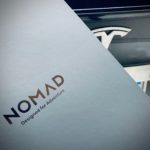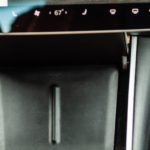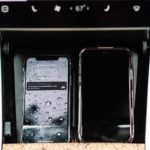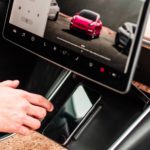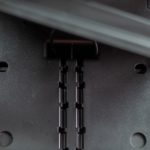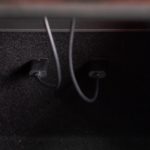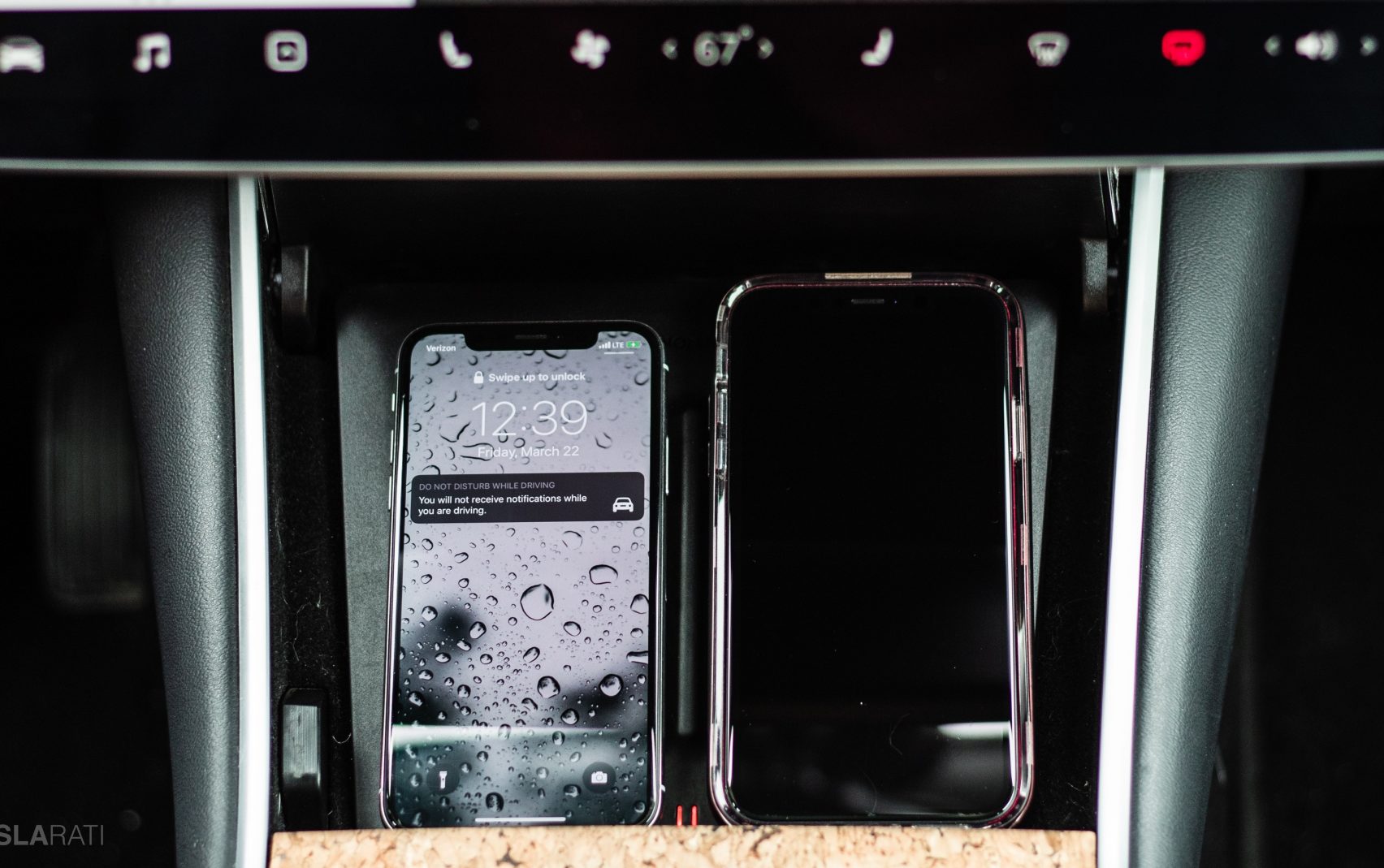
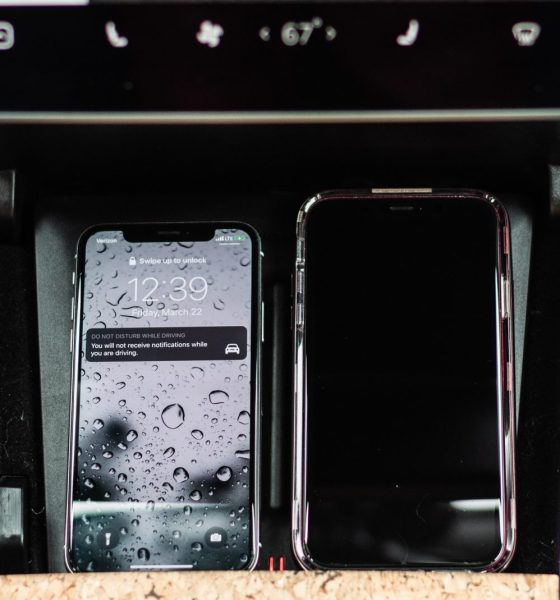
Lifestyle
Tesla Model 3 wireless charger: Factory-look and it’s fast
A big thanks to Nomad for providing me with this Model 3 wireless phone charger. This isn’t a mandatory glowing review – you can find those on YouTube. Rather, this was an opportunity for me, a product person, to inspect the design of a product that I needed/wanted and photograph it. I like photos. A lot.
The Tesla Model 3 is full of forward-thinking technology and amazing performance stats, but if I’m being honest, its built-in elements for phone charging have some room for improvement.
In a car that requires neither gas nor keys to operate, wireless phone charging seems like a natural fit, but it isn’t a factory option (yet anyhow). Thankfully, a company called Nomad has recognized the void in charger options and now offers a product specifically designed for the Model 3.
I got a hold of one and had a look for myself.

The Nomad Wireless Phone Charger for the Tesla Model 3 is basically what it sounds like – a pad for charging your compatible iPhone or Android device (7.5 W charge output or Qi-enabled) simply by setting it down in your car’s center console. An LED indicator confirms the process is working: amber while charging, and white when fully charged. Since Nomad’s charger supports two phones, your passenger can enjoy the same wire-free perks that you do. My passenger definitely appreciated it when I was trying the device out.
Even though I was looking for an improvement to my Model 3’s factory phone charging options, I’m still a huge fan of the Tesla aesthetic and wince at the idea of interfering with the look and feel of my car. That said, I was really pleased with how Nomad’s charger matched my Model 3’s design. It’s actually one of the core reasons I chose their charger over the many other wireless chargers that I saw were available on Amazon.

Photo by me.
Since there’s obviously a lot of motion involved while driving, Nomad’s pad has a matte black, soft rubber coating to keep your phone from sliding around. For small phones, spacers are included for extra stability which is a pretty cool compatibility consideration in my opinion. The specs of the charger say that some larger phones won’t fit into the charging space with their cases on, but my iPhone fits perfectly.
I did look at other wireless pads on the market that utilize a horizontal charging position, but personally didn’t like that look, and found Nomad’s upright mount to simulate more of the Tesla look and feel that’s similar to the Model S and Model X. Also, this is a minor detail to some, but it’s worth noting that I finally reached out to Nomad for a charger after seeing online reviews indicating that their charging was faster than the competition.
In terms of installation? Easy peasy. Open the top center console; remove the non-slip pad and USB cables inside Nomad’s Apple-like packaging; feed Nomad’s wires through the cable hole and plug into the Model 3’s USB ports. Not much to write about beyond that.
Photos by me.
While the standard setup of the Nomad charger worked great for my needs now, I also liked that there’s flexibility with the product in case my needs change in the future. For example, two USB splitters are included in the box if I have an audio device that requires a USB port or I want to record video from my dashcam.
Overall, I’m pretty satisfied with Nomad’s wireless phone charger in my Tesla Model 3. If you’re in the market for a factory-looking wireless charger, that charges quickly and has a solid, premium build, I recommend giving this phone charger a go. Full specs and pricing details can be found on Nomad’s website.
Thanks for listening and happy charging!

Lifestyle
Tesla Model S Plaid battles China’s 1500 hp monster Nurburgring monster, with surprising results
There is just something about Tesla’s tuning and refinement that makes raw specs seem not as game-changing.

The Tesla Model S Plaid has been around for some time. Today, it is no longer the world’s quickest four-door electric sedan, nor is it the most powerful. As per a recent video from motoring YouTube channel Carwow, however, it seems like the Model S Plaid is still more than a match for some of its newer and more powerful rivals.
The monster from China
The Xiaomi SU7 Ultra is nothing short of a monster. Just like the Model S Plaid, it features three motors. It also has 1,548 hp and 1,770 Nm of torque. It’s All Wheel Drive and weighs a hefty 2,360 kg. The vehicle, which costs just about the equivalent of £55,000, has been recorded setting an insane 7:04.957 at the Nurburgring, surpassing the previous record held by the Porsche Taycan Turbo GT.
For all intents and purposes, the Model S Plaid looked outgunned in Carwow’s test. The Model S Plaid is no slouch with its three motors that produce 1,020 hp and 1,420 Nm of torque. It’s also a bit lighter at 2,190 kg despite its larger size. However, as the Carwow host pointed out, the Model S Plaid holds a 7:25.231 record in the Nurburgring. Compared to the Xiaomi SU7 Ultra’s record, the Model S Plaid’s lap time is notably slower.
Real-world tests
As could be seen in Carwow’s drag races, however, Tesla’s tech wizardry with the Model S Plaid is still hard to beat. The two vehicles competed in nine races, and the older Model S Plaid actually beat its newer, more powerful counterpart from China several times. At one point in the race, the Xiaomi SU7 Ultra hit its power limit due to its battery’s temperature, but the Model S Plaid was still going strong.
The Model S Plaid was first teased five years ago, in September 2020 during Tesla’s Battery Day. Since then, cars like the Lucid Air Sapphire and the Xiaomi SU7 Ultra have been released, surpassing its specs. But just like the Model Y ended up being the better all-rounder compared to the BYD Sealion 7 and the MG IM6, there is just something about Tesla’s tuning and refinement that makes raw specs seem not as game-changing.
Check out Carwow’s Model S Plaid vs Xiaomi SU7 drag race video below.
Lifestyle
500-mile test proves why Tesla Model Y still humiliates rivals in Europe
On paper, the BYD Sealion 7 and MG IM6 promised standout capabilities against the Model Y.

BYD is seeing a lot of momentum in Europe, so much so that mainstream media has taken every opportunity to argue that the Chinese automaker has beaten Tesla in the region. But while BYD sales this year in Europe are rising and Tesla’s registrations remain challenged, the raw capabilities of vehicles like the Model Y are difficult to deny.
This was highlighted in a 500-mile challenge by What Car? magazine, which showed that the new Tesla Model Y is more efficient, cheaper to run, and more reliable than rivals like the BYD Sealion 7, and even the nearly 400 KW-charging MG IM6.
Range and charging promises
On paper, the BYD Sealion 7 and MG IM6 promised standout capabilities against the Model Y. The Sealion 7 had more estimated range and the IM6 promised significantly faster charging. When faced with real-world conditions, however, it was still the Model Y that proved superior.
During the 500-mile test, the BYD nearly failed to reach a charging stop, arriving with less range than its display projected, as noted in a CarUp report. MG fared better, but its charging speeds never reached its promised nearly-400 kW charging speed. Tesla’s Model Y, by comparison, managed energy calculations precisely and arrived at each stop without issue.
Tesla leads in areas that matter
Charging times from 25% to 80% showed that the MG was the fastest at 17 minutes, while Tesla and BYD were close at 28 and 29 minutes, respectively. Overall efficiency and cost told a different story, however. The Model Y consumed 19.4 kWh per 100 km, compared to 22.2 for MG and 23.9 for BYD. Over the full trip, Tesla’s charging costs totaled just £82 thanks to its supercharger network, far below BYD’s £130 and MG’s £119.
What Car? Magazine’s testers concluded that despite BYD’s rapid sales growth and the MG IM6’s seriously impressive charging speeds, Tesla remains the more compelling real-world choice. The Model Y just offers stability, efficiency, and a proven charging infrastructure through its Supercharging network. And as per the magazine’s hosts, the Model Y is even the cheapest car to own among the three that were tested.
Watch What Car? Magazine’s 500-mile test in the video below.
Lifestyle
Tesla Cybertruck slapped with world’s least intimidating ticket, and it’s pure cringe
One cannot help but cringe and feel second-hand embarrassment at the idea of a person just driving around with a stack of these babies.

A Cybertruck parked at Stanford Shopping Center in California was recently hit with what might be the most try-hard piece of paper ever slipped under a wiper blade: a “fake citation” accusing the driver of supporting a “fascist car.”
The note, shared on X by Tesla staff program manager Ryan Torres, quickly made the rounds on X, where it quickly gained attention as an example of how not to protest.
The world’s least intimidating ticket
According to the citation, the supposed “violation” was “driving a fascist car.” The remedial action? Take the bus, call an Uber, or ride a bike. The note also dubbed Elon Musk a “chainsaw-wielding Nazi billionaire.” Now, protests against Tesla and Elon Musk have become commonplace this year, but one cannot help but cringe and feel second-hand embarrassment at the idea of a person just driving around with a stack of fake anti-Tesla/Musk citations.
Torres pointed out the irony himself in his post on X. Tesla currently employs over 140,000 Americans, and SpaceX has put the U.S. firmly back at the top of space technology. As Torres put it, maybe the person behind the world’s least intimidating ticket should “read a book on innovation before vandalizing” other people’s property.
Peak performative clownery
Not to mention that the fake ticket’s logic collapses under its own weight. EVs like the Cybertruck are literally designed to reduce emissions, not “destroy the economy.” If anything, Tesla has bolstered the United States’ economy by fueling jobs in engineering, manufacturing, and clean energy. It’s not the first time a Tesla has been the target of vandalism or politically charged notes, but this one stands out for sheer cringe value.
Torres summed it up neatly: “Peak clownery.” On that point, at least, the citation earns full marks. In a way, though, perhaps cringe fake tickets are not as bad as the literal firebombs that were being thrown at Tesla stores and cars earlier this year because some critics were gleefully misinformed about Elon Musk.
